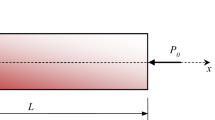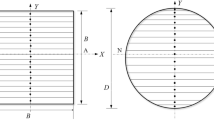This theoretical paper is devoted to a non-linear rheological model and its application in fracture analysis of a beam structure with an arbitrary number of longitudinal vertical cracks. The beam under consideration is a functionally graded material with viscoplastic behavior. The rheological model is structured by springs, dashpots, and a frictional slider that considers the plastic strains in the beam. The model is with two consecutive units. Solutions for the time-dependent strain energy release rate for each crack in the functionally graded beam structure under external mechanical loading are obtained using the rheological model. The J-integral is applied to control the solutions obtained. The solutions consider the viscoplastic behavior and the progressive variation of functionally graded material properties in the beam structure. It is shown that the solution derived in the present paper can be applied to examine the relation between the distribution of mechanical properties and the longitudinal fracture in functionally graded structural materials with viscoplastic behavior.





Similar content being viewed by others

References
T. Hirai and L. Chen, “Recent and prospective development of functionally graded materials in Japan,” Mater Sci Forum, 308–311, No. 4, 509–514 (1999).
S. Shrikantha Rao and K. V. Gangadharan, “Functionally graded composite materials: an overview,” Proc Mat Sci, 5, No. 1, 1291–1299 (2014).
A. Saiyathibrahim, R. Subramaniyan, and P. Dhanapl, “Centrifugally cast functionally graded materials – a review,” in: Proc. of the Int. Conf. on Systems, Science, Control, Communications, Engineering and Technology (2016), pp. 68–73.
R. J. Butcher, C. E. Rousseau, and H. V. Tippur, “A functionally graded particulate composite: measurements and failure analysis,” Acta Mater, 47, No. 2, 259–268 (1999).
I. M. El-Galy, B. I. Saleh, and M. H. Ahmed, “Functionally graded materials classifications and development trends from industrial point of view,” SN Appl Sci, 1, 1378 (2019).
A. Sola, D. Bellucci, and V. Cannillo, “Functionally graded materials for orthopedic applications – an update on design and manufacturing,” Biotechnol Adv, 34, 504–531 (2016).
W. Yan, W. Ge, J. Smith, et al., “Multi-scale modelling of electron-beam melting of functionally graded materials,” Acta Mater, 115, 403–412 (2016).
H. S. Hedia, S. M. Aldousari, A. K. Abdellatif, and N. A. Fouda, “New design of cemented stem using functionally graded materials (FGM),” Biomed Mater Eng, 24, 1575–1588 (2014).
Y. Zhang, M. J. Sun, and D. Zhang, “Designing functionally graded materials with superior load-bearing properties,” Acta Biomater, 8, 1101–1108 (2011).
M. M. Nemat-Allal, M. H. Ata, M. R. Bayoumi, and W. Khair-Eldeen, “Powder metallurgical fabrication and microstructural investigations of aluminum/steel functionally graded material,” Materials Sciences and Applications, 2, No. 12, 1708–1718 (2011).
M. M. Gasik, “Functionally graded materials: bulk processing techniques,” Int J Mater Prod Tec, 39, Nos. 1–2, 20–29 (2010).
J. Toudehdehghan, W. Lim, K. E. Foo, et al., “A brief review of functionally graded materials,” MATEC Web Conf, 131, 03010 (2017).
M. Nagaral, P. H. Nayak, H. K. Srinivas, and V. Auradi, “Characterization and tensile fractography of nano ZrO2 reinforced copper-zinc alloy composites,” Frattura ed Integrità Strutturale, 13, 370–376 (2019).
R. M. Mahamood and E. T. Akinlabi, Functionally Graded Materials, Springer (2017).
A. J. Markworth, K. S. Ramesh, and W. P. Parks, Jr., “Modeling studies applied to functionally graded materials,” J Mater Sci, 30, 2183–2193 (1995).
Y. Miyamoto, W. A. Kaysser, B. H. Rabin, et al., Functionally Graded Materials: Design, Processing and Applications, Kluwer Academic Publishers, Dordrecht–London–Boston (1999).
S. K. Bohidar, R. Sharma, and P. R. Mishra, “Functionally graded materials: a critical review,” International Journal of Research, 1, No. 7, 289–301 (2014).
J. W. Knoppers, J. Gunnink, J. van den Hout, and W. van Vliet, “The reality of functionally graded material products,” in: TNO Science and Industry, The Netherlands (2003), pp. 38–43.
V. Rizov and H. Altenbach, “Multi-layered non-linear viscoelastic beams subjected to torsion at a constant speed: a delamination analysis,” Engineering Transactions, 70, 53–66 (2022).
V. Rizov, “Analysis of longitudinal fracture in a non-linear viscoelastic beam under strains changing smoothly with time,” Procedia Structural Integrity, 41, 134–144 (2022).
D. Broek, Elementary Engineering Fracture Mechanics, Springer (1986).
Author information
Authors and Affiliations
Corresponding author
Additional information
Translated from Problemy Mitsnosti, No. 1, p. 125, January – February, 2024
Rights and permissions
Springer Nature or its licensor (e.g. a society or other partner) holds exclusive rights to this article under a publishing agreement with the author(s) or other rightsholder(s); author self-archiving of the accepted manuscript version of this article is solely governed by the terms of such publishing agreement and applicable law.
About this article
Cite this article
Rizov, V.I. On the Application of Non-Linear Rheological Models In Longitudinal Fracture Analysis of Beams Made of Functionally Graded Materials. Strength Mater 56, 105–111 (2024). https://doi.org/10.1007/s11223-024-00631-x
Received:
Published:
Issue Date:
DOI: https://doi.org/10.1007/s11223-024-00631-x



